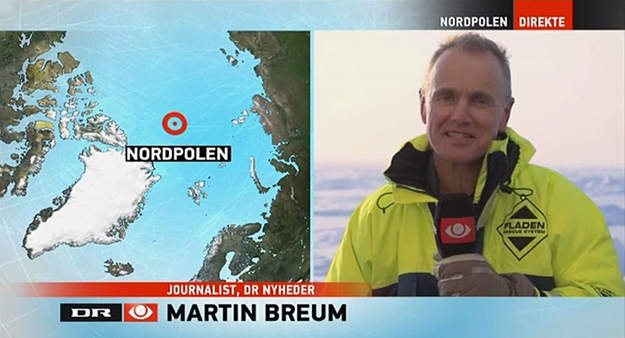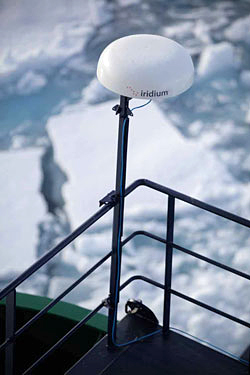Danish Broadcasting Corp. Goes Live from the North Pole

Martin Breum reporting from the North Pole for Danish TV.
NEW YORK — In today’s world, freedom of the press often means also having the ability to communicate — to convey the stories that need to be told from wherever they are around the world. In 2012, cinematographer and editor Kenneth Sorento and journalist Martin Breum pushed the limits while on assignment in the Arctic Ocean for Danish Broadcasting Corp. (DR).
As many are aware, the seabed in the Arctic is hotly contested, with several countries having laid claim to various parts of the ocean floor. In 2012, the Kingdom of Denmark sent an expedition to the North Pole to collect scientific data from the seabed to back its claim and symbolically place the Greenlandic and Danish flags, among other flags. Sorento and Breum traveled with the team reporting on the expedition.
“This was a peaceful mission, but it illustrated a key journalistic need — it is imperative for journalists to have control over your own communication channels and in some remote areas of the world this is incredibly challenging,” said Breum.
“On this journey, we needed to continually provide updates, interviews and coverage of the voyage and couldn’t rely on others giving us access on board the ship, so we turned to Polaris Electronics A/S, Keld M. Pedersen and Iridium to establish our own communication channel,” said Sorento.
Working with Polaris, the team chose gear that included the Iridium Pilot and the Iridium 9555 satellite phone. The Iridium Pilot, which is powered by Iridium OpenPort broadband service, provides reliable, high-quality voice and data communications from pole-to-pole.

Iridium Pilot antenna
Get the TV Tech Newsletter
The professional video industry's #1 source for news, trends and product and tech information. Sign up below.
“To say we were skeptical that we’d be able to easily manage a day-to-day production and reporting schedule from such a remote location would be a huge understatement,” said Sorento. “But that is exactly what we were able to do. It was business as usual, just from the Arctic Ocean.”
Being at sea for 49 days is challenging in itself, but for a freelance crew on assignment, staying in touch with editors is critical. In addition to being able to easily communicate with editors on their production needs and timing, the team conducted numerous live interviews and was able to consistently file video for use in stories despite the harsh conditions around them. The pinnacle of their work during the expedition was one of the most challenging — they had to file a 2.5-minute news story from the North Pole in a ready-to-run HD format.
“People kept saying that it wasn’t possible to send such a huge file over the Iridium satellite network, but it worked beautifully,” said Sorento.
Previously, Sorento had worked with a technician at the Danish Broadcasting Corporation to develop a special compression. With this, the team was able to compress the news item from 2.23 GB down to 40.6 MB with surprisingly little visible loss in image quality. They then sent the compressed file in three parts, enabling it to be more easily transmitted over the Iridium network. An editor at DR combined the three files received, and the story aired.
You can read more about this expedition and watch a video report (in Danish) by clicking this link.
“Overall, it was fabulous. The equipment worked so well; it let us focus on the work to be done,” said Sorento.
As other expeditions scout the Arctic Ocean, no doubt Iridium will be on board them as well. Iridium is the only satellite network that provides reliable communication at the poles, thanks to its 66-satellite mesh architecture.
